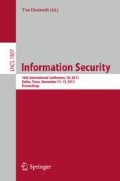Abstract
From contactless payments to remote car unlocking, many applications are vulnerable to relay attacks. Distance bounding protocols are the main practical countermeasure against these attacks. At FSE 2013, we presented SKI as the first family of provably secure distance bounding protocols. At LIGHTSEC 2013, we presented the best attacks against SKI. In this paper, we present the security proofs. More precisely, we explicate a general formalism for distance-bounding protocols. Then, we prove that SKI and its variants is provably secure, even under the real-life setting of noisy communications, against the main types of relay attacks: distance-fraud and generalised versions of mafia- and terrorist-fraud. For this, we reinforce the idea of using secret sharing, combined with the new notion of a leakage scheme. In view of resistance to mafia-frauds and terrorist-frauds, we present the notion of circular-keying for pseudorandom functions (PRFs); this notion models the employment of a PRF, with possible linear reuse of the key. We also use PRF masking to fix common mistakes in existing security proofs/claims.
The full version of this paper is available as [8].
Access this chapter
Tax calculation will be finalised at checkout
Purchases are for personal use only
Notes
- 1.
Due to space constraints, we refer to these papers for an overview of DB protocols.
- 2.
- 3.
In this paper, there is just one common input, i.e., we assume \(x=y\).
- 4.
- 5.
Here, we deviate from Definition 4 a bit by introducing \(P^*(x)\) in the MiM attack.
- 6.
References
Avoine, G., Bingöl, M., Kardas, S., Lauradoux, C., Martin, B.: A framework for analyzing RFID distance bounding protocols. J. Comput. Secur. 19(2), 289–317 (2011)
Avoine, G., Lauradoux, C., Martin, B.: How secret-sharing can defeat terrorist fraud. In: ACM Conference on Wireless Network Security, WISEC 2011, Hamburg, Germany, pp. 145–156. ACM (2011)
Bay, A., Boureanu, I., Mitrokotsa, A., Spulber, I., Vaudenay, S.: The bussard-bagga and other distance-bounding protocols under attacks. In: Kutylowski, M., Yung, M. (eds.) Inscrypt 2012. LNCS, vol. 7763, pp. 371–391. Springer, Heidelberg (2013)
Boureanu, I., Mitrokotsa, A., Vaudenay, S.: On the pseudorandom function assumption in (secure) distance-bounding protocols. In: Hevia, A., Neven, G. (eds.) LatinCrypt 2012. LNCS, vol. 7533, pp. 100–120. Springer, Heidelberg (2012)
Boureanu, I., Mitrokotsa, A., Vaudenay,S.: On the need for secure distance-bounding. In: Early Symmetric Crypto, ESC 2013, Mondorf-les-Bains, Luxembourg, pp. 52–60. University of Luxembourg (2013)
Boureanu, I., Mitrokotsa, A., Vaudenay, S.: Towards secure distance bounding. In: Moriai, S. (ed.) FSE 2013. LNCS, vol. 8424, pp. 55–68. Springer, Heidelberg (2014). http://eprint.iacr.org/2015/208.pdf
Boureanu, I., Mitrokotsa, A., Vaudenay, S.: Secure and lightweight distance-bounding. In: Avoine, G., Kara, O. (eds.) LightSec 2013. LNCS, vol. 8162, pp. 97–113. Springer, Heidelberg (2013)
Boureanu, I., Mitrokotsa, K., Vaudenay, S.: Practical and provably secure distance-bounding. To appear in the Journal of Computer Security (JCS). IOS Press, Eprint 2013/465. http://eprint.iacr.org/2013/465.pdf
Chernoff, H.: A measure of asymptotic efficiency for tests of a hypothesis based on the sum of observations. Ann. Math. Stat. 23(4), 493–507 (1952)
Cremers, C.J.F., Rasmussen, K.B., Schmidt, B., Capkun, S.: Distance hijacking attacks on distance bounding protocols. In: IEEE Symposium on Security and Privacy, S&P 2012, San Francisco, California, USA, pp. 113-127. IEEE Computer Society (2012)
Dürholz, U., Fischlin, M., Kasper, M., Onete, C.: A formal approach to distance-bounding RFID protocols. In: Zhou, J., Li, H., Lai, X. (eds.) ISC 2011. LNCS, vol. 7001, pp. 47–62. Springer, Heidelberg (2011)
Fischlin, M., Onete, C.: Terrorism in distance bounding: modeling terrorist-fraud resistance. In: Jacobson, M., Locasto, M., Mohassel, P., Safavi-Naini, R. (eds.) ACNS 2013. LNCS, vol. 7954, pp. 414–431. Springer, Heidelberg (2013)
Hancke, G.P: Distance bounding for RFID: effectiveness of terrorist fraud. In: Conference on RFID-Technologies and Applications, RFID-TA 2012, Nice, France, pp. 91–96. IEEE (2012)
Hancke, G.P., Kuhn, M.G.: An RFID distance bounding protocol. In: Conference on Security and Privacy for Emerging Areas in Communications Networks, SecureComm 2005, Athens, Greece, pp. 67-73. IEEE (2005)
Hoeffding, W.: Probability inequalities for sums of bounded random variables. J. Am. Stat. Assoc. 58, 13–30 (1963)
Kim, C.H., Avoine, G., Koeune, F., Standaert, F.-X., Pereira, O.: The swiss-knife RFID distance bounding protocol. In: Lee, P.J., Cheon, J.H. (eds.) ICISC 2008. LNCS, vol. 5461, pp. 98–115. Springer, Heidelberg (2009)
Vaudenay, S.: On modeling terrorist frauds. In: Susilo, W., Reyhanitabar, R. (eds.) ProvSec 2013. LNCS, vol. 8209, pp. 1–20. Springer, Heidelberg (2013)
Author information
Authors and Affiliations
Corresponding author
Editor information
Editors and Affiliations
Rights and permissions
Copyright information
© 2015 Springer International Publishing Switzerland
About this paper
Cite this paper
Boureanu, I., Mitrokotsa, A., Vaudenay, S. (2015). Practical and Provably Secure Distance-Bounding. In: Desmedt, Y. (eds) Information Security. Lecture Notes in Computer Science(), vol 7807. Springer, Cham. https://doi.org/10.1007/978-3-319-27659-5_18
Download citation
DOI: https://doi.org/10.1007/978-3-319-27659-5_18
Published:
Publisher Name: Springer, Cham
Print ISBN: 978-3-319-27658-8
Online ISBN: 978-3-319-27659-5
eBook Packages: Computer ScienceComputer Science (R0)

